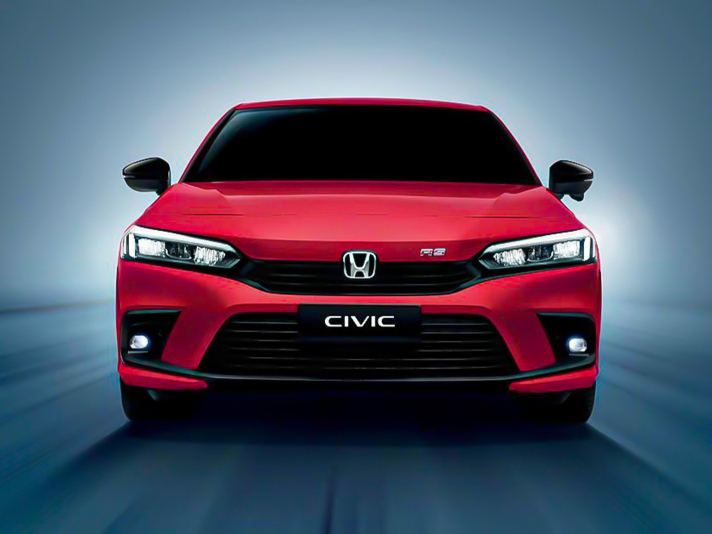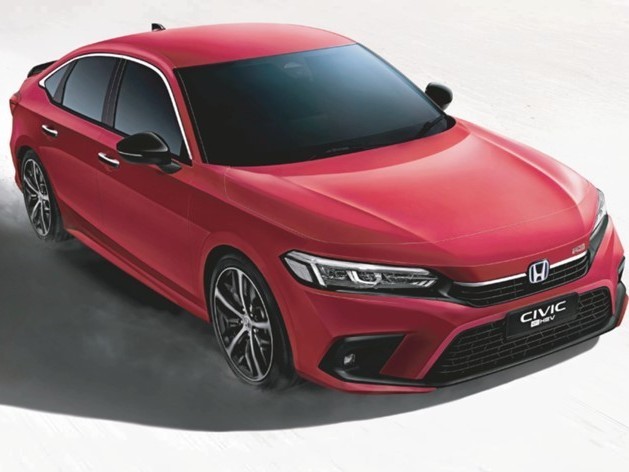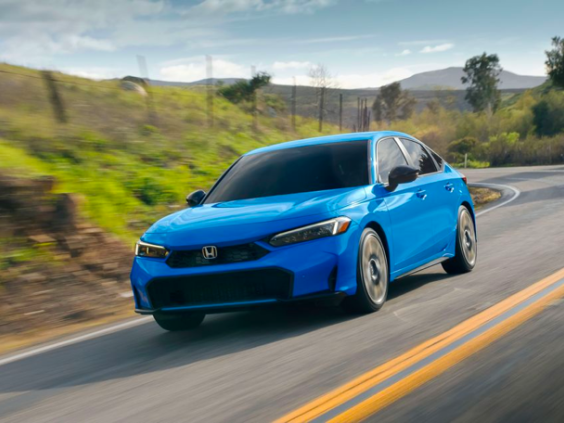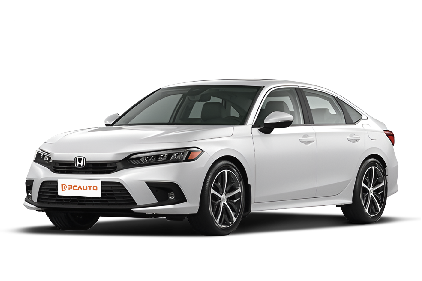Q
how much honda civic hybrid battery cost
The cost of replacing the battery for a Honda Civic Hybrid can vary due to several factors. Generally speaking, in Malaysia, the cost of battery replacement is typically in the range of several thousand ringgit. However, the exact price can differ depending on the battery model, market demand, and the repair shop. The common price range is usually between RM 5,000 and RM 10,000.
Special Disclaimer: This content is published by users and does not represent the views or position of PCauto.
Related Q&A
Q
What Segment Does Honda Civic Belong to?
The Honda Civic belongs to the C-Segment, which is in the compact car category. Compact cars typically have a body length ranging from 4.2 to 4.6 meters, focusing on being price - friendly, fuel - efficient, and convenient for daily use, with a design that balances practicality and driving pleasure.
The Honda Civic has a body length of about 4.6 meters. This size ensures ample interior space and handling flexibility. It offers a variety of power options, from naturally - aspirated to turbocharged engines, which can meet the needs of different consumers. The body design emphasizes aerodynamics and a modern look. With a young and stylish appearance, it's suitable for urban commuting and family trips. In the market, the Civic's direct competitors usually include other compact cars in the same class, such as the Toyota Corolla, Volkswagen Golf, Mazda 3, and Hyundai Elantra.
Q
What Is the Reslae Value of Honda Civic?
The Honda Civic maintains strong resale value in the used car market, consistently ranking among the best-retaining Japanese sedans in its class , particularly the newer tenth-generation (FC) and eleventh-generation (FK) models. Industry data shows Civic typically depreciates only 20%-30% over the first three years (depending on condition, mileage and market demand). For example, a 2020 Civic 1.5 TC originally priced around RM130k can still be priced at RM90k-RM100k in today's used market (varying by trim and maintenance history).
This exceptional value retention benefits from Honda's brand reputation, the appeal of its turbocharged engine (1.5L VTEC Turbo), and relatively low maintenance costs - though the base 1.8L naturally aspirated versions fetch slightly lower (yet still competitive) prices. Generally, low-mileage examples (under 15,000km annually) with complete service records and accident-free history are the most popular, while higher trims with Honda Sensing (like 1.5 TC-P) command premium resale prices over standard versions.
Additional factors affecting resale value include: preferred colors (white/gray being most popular), remaining factory warranty coverage, and aftermarket modifications (which may actually decrease value). Owners are advised to maintain regular authorized service center visits and keep complete documentation to maximize future resale potential.
Q
What's the Engine Displacement of Honda Civic?
The Honda Civic provides a variety of models with different displacements. The common displacements are 1.5L and 2.0L. When converted to CC (cubic centimeter, where 1L = 1000CC), they correspond to 1498CC and 1993CC respectively. The 1.5L models generally adopt the turbo - charged intake form, offering a fairly abundant power output, which can meet the needs of daily driving and some scenarios with certain power requirements. The 2.0L e:HEV RS model, on the other hand, is a gasoline - electric hybrid (HEV). It combines the advantages of the engine and the electric motor. While providing good power, it also boasts excellent fuel economy. Each model with different displacements has its own characteristics, and consumers can make a choice based on their own needs and preferences.
Q
What Engine Is Equipped by Honda Civic?
The Honda Civic offers multiple engine configurations. A common option is the 1.5L Turbo engine, featuring turbocharged intake with a displacement of 1498mL. It delivers a maximum horsepower of 182PS (134kW) at 6000rpm and peak torque of 240N·m between 1700-4500rpm. This inline-4 cylinder engine adopts an L-type cylinder arrangement.
Another available configuration is the 2.0L e:HEV RS, which utilizes naturally aspirated (NA) intake with a 1993mL displacement. The combustion engine produces 143PS (105kW) at 6000rpm and 189N·m of torque at 4500rpm. Combined with its electric motor, the hybrid system generates an additional 184PS (135kW) and 315N·m of torque.
These different engine options cater to varying consumer needs and driving preferences. The 1.5L Turbo provides robust power output, appealing to performance-oriented drivers, while the 2.0L e:HEV RS hybrid configuration balances adequate power delivery with superior fuel efficiency.
Q
What Is the Gearbox Type of Honda Civic?
The gearbox types of the Honda Civic vary depending on the model and year. Common transmission types include Continuously Variable Transmission (CVT) and Electronically Controlled Continuously Variable Transmission (E - CVT).
For gasoline - powered Honda Civic models, such as the 2025 Honda Civic 1.5L E, 1.5L V, and 1.5L RS, they are equipped with CVT. This type of transmission can provide a smooth driving experience and help optimize fuel efficiency. Unlike traditional transmissions, CVT doesn't have distinct gears and can achieve seamless changes in the transmission ratio according to driving conditions.
The 2025 Honda Civic 2.0L e:HEV RS is a gasoline - hybrid model, which uses E - CVT. This is specifically designed for hybrid vehicles. It combines the power of the engine and the electric motor, further improving fuel economy and providing a refined driving experience. The E - CVT manages the power distribution between the two power sources to ensure efficient operation in different driving scenarios.
Q
What Is the Pitch Circle Diameter of Honda Civic?
PCD (Pitch Circle Diameter) refers to the diameter of the central circle of the bolt holes in an automobile wheel hub. The PCD sizes of Honda Civic vary across different years and versions. Although the PCD dimensions may vary across different model years and versions of the Honda Civic, the given information does not explicitly specify the PCD. However, based on common wheel bolt-hole references for models like the 2022–2025 Civic, which have various tire sizes (e.g., 215/55 R16, 215/50 R17, 235/40 ZR18), the PCD in the Malaysian automotive market is typically 5x114.3mm—a widely compatible size.
For precise measurements, it is recommended to consult Honda authorized dealers or professional automotive workshops, as they can provide accurate PCD specifications for specific vehicle models.
Q
Is Honda Civic Equipped with Apple Carplay?
The currently available 11th-generation Honda Civic (Honda Civic 2023 FK) comes standard with Apple CarPlay wireless connectivity across the whole range (wired connection may also be retained in some models). Paired with a 9 - inch high - definition touchscreen, it seamlessly integrates navigation, music, and call operations for iPhone users.
As for the previous 10th - generation Civic (FC models), the mid - cycle facelift versions after 2019 (some 1.5 TC/TC - P models) also started to introduce Apple CarPlay. However, it should be noted that the early FC versions from 2016 - 2018 only support the Honda original system. If you want CarPlay, you may need to install a third - party module by yourself.
It is recommended that before buying a car, you confirm whether the function is available through the "Smartphone Connection" icon in the upper - right corner of the in - car screen or check the voice command button (with a microphone icon) on the steering wheel. If you're buying a used car, you can ask to test the compatibility by connecting your phone.
In addition, Honda Malaysia has been actively upgrading the in - car system in recent years. The new - generation Civic supports wireless Android Auto and maintains stable compatibility with the iOS system (it is recommended to use iOS 14 or later). In the future, system updates may further optimize the connection stability and response speed.
Q
What Is the Brand of Honda Civic's Tire?
The original - equipped tire brands adopted by the Honda Civic vary depending on different model years, vehicle types, and regional dealerships. Commonly, they include Michelin (such as Primacy 4 or Pilot Sport 4), Yokohama (like Advan dB or BluEarth - GT), and Bridgestone (Turanza T005A). These tires are characterized by their quietness, wear resistance, and wet - grip performance, which align with Honda's positioning for the Civic's well - balanced performance.
For example, the high - end 1.5 TC - P model might come with the higher - performance Michelin Pilot Sport series, while the entry - level 1.8S could be paired with more economy - oriented Yokohama tires. It's recommended that owners check the markings on the tire sidewall to confirm the specific model (e.g., 215/50 R17).
In addition, vehicles from different batches may have their tire brands changed due to supply - chain adjustments. If owners have higher requirements for the performance of the original tires, they can consult the authorized service center during maintenance or upgrade the tires on their own (such as choosing Continental or Goodyear). However, it's important to note that the tire size and load index must match the original specifications (most FK5 - generation models use 215/50 R17 or 235/40 R18) to ensure driving safety and maintain warranty rights.
Q
Is Honda Civic a Good Car? Learn the Pros and Cons Here
The Honda Civic is generally regarded as a good car with both advantages and disadvantages. Regarding its advantages, it has good performance. Some models are equipped with turbocharged engines, which can offer a pleasant acceleration experience. For example, the models equipped with a 1.5 - liter turbocharged engine can reach a maximum speed of 200 kilometers per hour. Its fuel economy is also quite good. The official combined fuel consumption of some models is about 6 liters per 100 kilometers, which helps to save the usage cost.
In terms of handling, the Civic benefits from its well - tuned suspension. The combination of the MacPherson front suspension and the multi - link rear suspension can provide a stable driving and riding experience and sensitive handling performance whether on city streets or highways. Safety performance is also one of its highlights. It comes standard with a series of safety features, such as multiple airbags, Anti - lock Braking System (ABS), and Electronic Stability Control, making you feel more secure on the road. The interior design is user - friendly, and the overall workmanship quality is usually reliable.
However, it also has some drawbacks. Some drivers may find the noise level, especially the road noise and wind noise at high speeds, a bit annoying. The rear - seat space may seem a bit cramped for taller passengers. In addition, compared with some competitors, its price may be relatively high. But overall, if you value performance, safety, and handling more than an absolutely quiet interior environment and the largest rear - seat space, then the Honda Civic is a good choice.
Q
What Is the Width of Honda Civic?
The width of the Honda Civic varies depending on different models and generations. Generally speaking, for the models listed here, the Honda Civic has a width of 1,802 millimeters. This dimension affects the vehicle's overall footprint on the road, affecting stability while driving, the space it takes up in parking lots and so on. It also has an impact on the interior space available to passengers. The wider the body, the more shoulder and elbow room passengers may have. Keep in mind that these dimensions may vary for newer or different versions of the Honda Civic.
Latest Q&A
Q
What is the Second Hand Price of Toyota Harrier? Check Here!
In Malaysia, the prices of used Toyota Harriers vary depending on the vehicle's condition, year, mileage, and configuration. Generally speaking, the prices of used Harriers from the 2015-2018 models range from around 120,000 to 180,000 Malaysian ringgit. Meanwhile, the newer 2019-2021 models may cost between 180,000 and 250,000 ringgit. The exact price needs to be comprehensively evaluated based on factors such as the vehicle's maintenance records, accident history, and market demand.
As a mid-sized SUV under the Toyota brand, the Harrier is quite popular in the Malaysian market for its reliability and comfort. In particular, the hybrid version is favored by consumers with a strong sense of environmental protection. When buying a used car, it is recommended to check the vehicle's condition through formal channels, compare prices with reference to the market situation, and pay attention to confirming whether the vehicle has complete maintenance records and legal procedures to ensure a safe transaction.
In addition, the Harrier has a relatively high resale value, partly due to the good reputation of the Toyota brand in Malaysia and its low maintenance costs. However, the specific price still needs to be adjusted according to real-time market dynamics.
Q
What is the Engine Oil Capacity of Toyota Harrier ?
The engine oil capacity of the Toyota Harrier varies depending on the model year and engine type. For example, the common 2.0-liter turbocharged engine (8AR FTS) typically requires about 5.7 liters of oil when including the oil filter. Meanwhile, the 2.5-liter hybrid version (A25A FXS) generally needs around 4.8 liters. However, the exact amount should always be determined using the dipstick to avoid overfilling or underfilling.
In Malaysia’s hot climate, it is recommended to use fully synthetic engine oil that meets Toyota’s SN or SP-grade standards, such as 5W30 or 0W20. These oils are better suited for high temperatures and can help extend engine life. It is essential to check the oil condition regularly, ideally every 5,000 kilometers or six months. If the oil appears dark or has lost its viscosity, it should be changed promptly.
Some newer Harrier models may come with an oil life monitoring system, but it is still advisable for owners to manually inspect the oil level and condition to ensure accuracy. The most reliable reference remains the original maintenance manual, which provides the precise oil capacity and recommended specifications for each specific model.
Q
What is the Road Tax Price of Toyota Harrier? How to Calculate it?
In Malaysia, the road tax price of the Toyota Harrier is calculated based on its engine capacity. The specific cost depends on the vehicle's year and displacement. For example, the annual road tax for the 2.0L version is about RM380, while that for the 2.5L hybrid version is about RM1,140. The actual amount may be slightly adjusted according to the state. When calculating the road tax, you need to refer to the JPJ's rate table. The formula is the basic rate multiplied by the engine capacity (in liters). Meanwhile, hybrid models enjoy some tax incentives.
Apart from the road tax, car owners also need to understand the importance of vehicle insurance and regular maintenance. Insurance costs usually depend on the car price, car age, and insurance coverage. Regular maintenance can ensure the vehicle's performance and extend its service life.
Malaysia's automobile tax system also includes import duties and sales taxes. These costs are already included in the total price when purchasing the car. Therefore, car owners only need to renew the road tax and insurance annually to legally drive on the road.
Q
What is the Width of Toyota Harrier?
The body width of the Toyota Harrier is 1,890 millimeters, making it one of the wider designs among SUVs in its class. This allows for generous lateral space inside the cabin, enhancing passenger comfort, especially for Malaysian families during long-distance travel. The Harrier's wide body also contributes to greater driving stability. Together with its streamlined shape, it reduces wind resistance and improves fuel efficiency.
The broader body also enables a more flexible interior layout. For example, the rear seats can be reclined, and the trunk offers a generous 487 liters of space, which expands to 1,278 liters when the seats are folded down. This makes it ideal for weekend getaways or shopping trips, both popular activities among Malaysian drivers.
Although the Harrier’s width slightly exceeds 1.8 meters, it still fits comfortably into standard Malaysian parking spaces, which are typically around 2.5 meters wide. Daily use remains convenient. The vehicle’s dimensions strike a strong balance between spacious practicality and agile handling. Built on the TNGA-K platform, the Harrier features enhanced chassis rigidity. This solid foundation ensures the wide body maintains precise steering control even through curves, making it well suited to Malaysia’s diverse road conditions, from mountainous terrain to city streets.
Q
Is Toyota Harrier a Good Car? Learn the Pros and Cons Here!
The Toyota Harrier is a popular SUV in the Malaysian market. Its advantages include a spacious and comfortable interior, excellent fuel economy, and the reliable quality that Toyota is known for. It's especially suitable for family use or long-distance driving. The 2.0L and 2.5L hybrid versions offer diverse power options to meet different driving needs. The hybrid versions are particularly fuel-efficient when driving in the city, making them a great fit for the common congested traffic conditions in Malaysia.
In addition, the Harrier comes with comprehensive safety features. The Toyota Safety Sense system is standard, which includes functions like pre-collision warning and lane-keeping assist, enhancing driving safety.
However, the Harrier has its drawbacks. Its price is relatively high, especially for the hybrid versions, and the maintenance costs are slightly higher than some of its competitors in the same class. Also, the space in the third-row seats is rather cramped, not very suitable for adults on long-term rides.
For Malaysian consumers, if they have a sufficient budget and value brand reputation and fuel efficiency, the Harrier is a good choice. But if they are looking for better value for money or more spacious seven-seat accommodation, they can also consider other models in the same class. Overall, the Harrier offers a well-balanced performance in terms of quality, comfort, and technology, making it a worthy SUV to consider.
View MoreRelated News

Honda Civic Interior Revealed: A Comprehensive Analysis of Civic’s Interior Charm
Kevin WongJul 10, 2025

Honda Civic Price Revealed: The Most Detailed Buying Guide!
AshleyApr 8, 2025

Whether it's about appearance or handling, why do young people all like Honda Civic?
WilliamSep 24, 2024

2022 Honda Civic: Hybrid car with the fastest acceleration, lowest fuel consumption, who says eco-friendly cannot be fast
JohnSep 3, 2024

2025 Honda Civic debuts, minor changes in appearance, has 1.5 Turbo model been discontinued?
LienMay 22, 2024
View More













 Cars
Cars




Pros
Cons